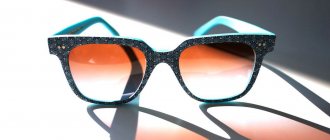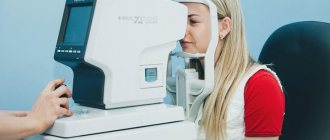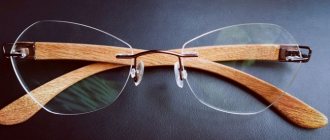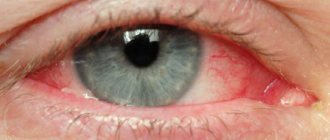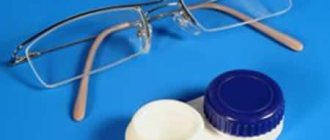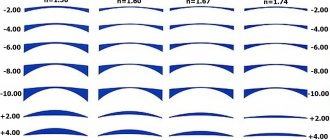In what cases should this method be used?
Glasses for vision correction are the most common way to get rid of problems associated with the incorrect operation of this analyzer. Naturally, it may not always be applied.
An ophthalmologist can prescribe glasses in cases where they will really help and will not cause inconvenience to the patient. In other cases, surgery, contact lenses, or other correction methods may be prescribed.
Glasses are used to correct astigmatism, farsightedness and other diseases. However, you should choose this attribute very carefully.
Should my child wear glasses or let the eye “work”?
When a pediatric ophthalmologist prescribes glasses for a child, some parents wonder whether they are really worth wearing. In many ways, the reason is the prevailing opinion that glasses can make your eyes “lazy” and stop “working.” This is an absolute misconception, which sometimes becomes a brake on the restoration of vision in a child and the normal development of his visual system. Considering that the formation of the eye and its structures occurs before the age of 14, if a child has visual impairments, wearing glasses can become a decisive factor in correcting vision in time and “teaching” the retina to see correctly.
How does a child develop good vision?
To understand the reasons for this fact, you need to remember what the visual organ is, how normal binocular vision is formed, and what are the reasons for its impairment. As you know, the eye is a very complex optical system. Simply put, it can be represented as a system of natural lenses formed by transparent fabrics and fibers that differ in optical characteristics, primarily in refractive index. Rays of light entering the eye pass through this entire optical system, refracting in it (in the cornea, lens, vitreous body.) As a result, a reduced and inverted image of an object is formed on the retina. This information is perceived by the light-sensitive nerve cells of the retina. They transmit it along the optic nerves to the brain, where after processing, the image is reversed again and becomes correct. That is why physiologists say that a person sees not with his eyes, but with his brain. However, one must understand that good vision for a person is provided by differences in the refractive abilities of the optical structures of the eye, which are mentioned above. Any physiological or pathological processes and malfunctions occurring in the body can significantly affect this ability, and therefore worsen vision.
What are visual impairments?
The eye, normally, has a shape almost close to a trigonometric figure - a sphere. Various diseases modify it in horizontal or vertical planes, turning the sphere into an ellipse. Such transformations greatly affect the acuity and focusing of vision.
When the refractive power of the optical system changes (ametropia), the spherical shape of the eye is also disrupted. This is associated with such common diseases among children as myopia, farsightedness and astigmatism. Let's take a closer look at how they are formed.
We must understand that myopia is not a disease, but a defect in the optics of the eye, in which the image of objects is focused not on the retina, but in front of it. With myopia, a person can clearly see close objects, but all distant objects look blurry.
Myopia can be axial, when the length of the eyeball (optical axis) is increased, or refractive - in this case, the cornea has a greater refractive power, resulting in a decrease in the focal length of the eye. More common is a combination of these two factors, as well as axial myopia, due to the fact that the eye has grown larger than necessary.
There are three degrees of myopia: low up to 3 diopters, medium - from 3 to 6 diopters and high - over 6 diopters.
If myopia is diagnosed in time and all necessary measures are taken, then in most cases it is possible to stop or significantly slow down its progression. During periods of active child growth, an increase in myopia over 0.5 diopters per year is considered progression.”
Myopia can be corrected with glasses with diverging lenses, hard nighttime contact lenses, or soft daytime contact lenses. According to the data, in the absence of timely correction, eye strain occurs and myopia will progress.
- Farsightedness (hypermetropia). In this case, the opposite is true - the eye seems to be slightly flattened in the longitudinal direction - the sagittal size is smaller than the transverse and vertical. In this case, the angle of refraction of the light beam is less than normal, and the focus of the optical system of the eye, conditionally, in a calm state is located behind the retina. Farsightedness, like myopia, manifests itself as an unclear and blurry image of objects. Only the distance of best vision here exceeds 25 centimeters. That is why, when examining an object, a person will try to move it away from the eyes, and wearing glasses with converging lenses or soft contact lenses will help normalize vision. But in preschool children, hyperopia is manifested by deterioration of vision both near and at a distance. One of the symptoms of moderate and high farsightedness may be the approach of objects (books, toys, notebooks) very close to the face when examined, the appearance of constant or episodic convergent strabismus after the age of 1 year.
- Astigmatism. Unlike farsightedness and myopia, this disorder is not associated with a change in the length of the eyeball. Astigmatism occurs due to unequal refraction of light rays in different directions by the cornea and lens (the optical system of the eye) due to individual congenital characteristics. So, if the curvature of the cornea in the horizontal section is less than in the vertical section, the image of an object on the retina will be unclear at any distance to it. In this case, the cornea seems to acquire two main focuses: for horizontal and vertical sections, respectively. Because of this, light rays are focused in different planes. For example, when focusing the horizontal lines of an object on the retina, the vertical lines of the object will appear in front of it. This disorder can be corrected by glasses with cylindrical lenses or special toric soft contact lenses.
Why the eye “does not work” or sees poorly
The eye has the ability to focus at different distances, thanks to which a person sees well both far and near. This process is called accommodation and is characterized by a change in the refractive power of the eye due to the curvature of the lens. So, when moving the gaze from a distant object to a nearby object, the muscles inside the eye tense, and the person focuses on the object - accommodates.
The closer the object in question is, the more the eye needs to accommodate. The distance of best vision is normally considered to be 35-40 centimeters. If the object is closer, the eye will not be able to look at the object for a long time without strain.
The eye can actively focus only with normal vision or farsightedness. With myopia, distance accommodation is not involved (the eye is already focused at a close distance). A myopic eye does not have a mechanism for focusing into the distance, so the eye cannot focus at long distances. To put it another way, with myopia the eye “does not work.” And the so-called work of the eye into the distance without glasses comes down to simple squinting, when by pressing the cornea with eyelids we weaken the optical power of the cornea and slightly improve vision. The situation can be corrected by changing the optics of the eye to a normal state, which is done with glasses or contact lenses in children and laser vision correction in adults.
With farsightedness, the eye becomes very tired due to accommodative stress. Even when it works, a person may experience difficulty operating at close range. Long-term wearing of glasses with this pathology allows you to reduce the strain of accommodation, which is not typical for a normal eye. Therefore, glasses for farsightedness are a necessary therapeutic factor. If there is a large degree of farsightedness (+6 diopters and above), it can cause “convergent” strabismus, since the eye is not able to independently overcome such farsightedness even with maximum visual strain.
All of the above shows that for the normal development of the child, his social adaptation and restoration of normal functions of the visual apparatus, glasses, taking into account the diagnosis, must be worn. If this is not done, not only the development of vision, but also the eye itself as a whole slows down. The child’s visual system will begin to function normally only after the brain receives a clear image of objects. And this, in case of refractive errors, is only possible with glasses or contact lenses.
Another argument in favor of optical correction (glasses, contact lenses) is the fact that wearing them prevents the development of certain pathologies (amblyopia, strabismus), and according to some data, slows down the progression of myopia.
Of course, whether a child wears glasses prescribed by a pediatric ophthalmologist or not is up to the parents to decide. But you should be aware that correctly selected and timely prescribed glasses make it possible to improve your vision and see well over time (without them, or by reducing their strength). If you refuse to wear glasses, then even with complex treatment, you most likely will not be able to achieve a 100% result. Therefore, in order not to miss the moment, to respond to the problem in time and begin treatment, it is necessary to regularly visit a pediatric ophthalmologist. This should be done annually even without visible indications.
Classification of lenses
Before choosing glasses for vision correction, you need to understand what they are. That is, you will have to pay attention not only to the frame, but also to the lenses. There are many characteristics by which the presented product is classified. Let's look at just a few of them:
1. According to optical effect:
- afocal;
- for myopic people;
- for farsighted people;
- astigmatic;
- prismatic;
- stigmatic.
2. According to the degree of light transmission:
- photochromic;
- sun protection;
- transparent.
3. Glasses for vision correction can have different types of coating:
- providing a high degree of light transmission;
- changing the shade of lenses;
- ensuring no glare;
- preventing mechanical damage to lenses;
- protects against radiation while working at a computer.
Naturally, there are products with different degrees of light refraction. And the thinner the lens, the greater this indicator. Mineral lenses can provide the maximum indicator of this parameter.
Prismatic glasses for vision correction are a product with specific glasses. That is, they combine several types of lenses. Most often, prismatic and spherical elements are combined. The glasses presented are considered more effective for correcting certain vision defects. Therefore, keep in mind that you cannot use such an accessory yourself, as this can worsen the situation.
Advantages and disadvantages of lenses made of different materials
Today, glasses for vision correction are made from various raw materials. Naturally, each material has its own advantages and disadvantages. So, such lenses exist.
From glass. They can last a long time, do not change transparency, are able to block a significant amount of ultraviolet radiation, and also perfectly perceive impurities of photochromic elements. However, glass can be easily broken if you handle your glasses carelessly. In addition, such lenses are quite difficult to process. In some cases, they cannot provide the required effect and make the glasses very bulky, bulky and heavy.
- Made of plastic. This material is very light, does not cause inconvenience, has a more attractive appearance, and does not break when dropped. In addition, plastic can be used to make double-curved lenses, which is why they are most often used to treat astigmatism. Today, plastic glasses are predominantly chosen for vision correction. They have mostly positive reviews, although they are much more expensive than glass ones. In addition, they are more susceptible to mechanical damage, become brittle when exposed to low temperatures, accumulate static electric charge and require the most careful handling.
In any case, the choice is yours.
Features of choosing a frame
In order for the presented product to be comfortable to wear, it is necessary to choose it correctly. This applies not only to lenses, but also to frames. In order to buy what you need, try to follow these tips:
- The frame must fit well on the bridge of the nose and on the ears (you should not feel any discomfort). In this case, the product should not slip.
- You should pay attention to the coating of the frame. It must be hypoallergenic.
- Give preference to silicone nose pads: they do not pinch and can adapt to the shape of the bridge of the nose.
- The material of manufacture is also an important selection criterion. Metal is more expensive and durable, which cannot be said about plastic.
- When choosing, consider your style, because glasses can become your fashion statement.
Important points when buying children's glasses
There are two key aspects to choosing glasses: physical and psychological. The physical aspect includes wearing comfort and sizing, and the psychological aspect includes satisfaction with the reflection in the mirror.
The physical aspect of choosing glasses
Let's start with the physical aspect and study what characteristics of vision glasses, in addition to diopters, to pay attention to before purchasing.
Size
The size is indicated on the inside of the left temple. It must exactly correspond to anthropological parameters. Points are not taken for growth, but a slight deviation is acceptable:
- +/- 3-5 mm – frame width
- +/- 1 mm – bridge width
- +/- 1-5 mm – length of temples
Lens material
Lenses of modern models can be made from several types of materials:
- Polycarbonate is a lightweight, impact-resistant material that is comfortable and safe to wear. When broken, polycarbonate lenses crack or split into two large parts.
- Trivex is less impact resistant than polycarbonate, but is also an even lighter material. Provides excellent peripheral vision quality (no rainbow effect around the object).
- Plastic is an inexpensive, thin and lightweight material, popular among sports glasses. A significant disadvantage is that without applying a special coating, scratches quickly appear on it.
- Glass is a traditional lens material. Such lenses are durable and at the same time fragile, resistant to temperature changes, and at the same time easily fog up.
Glass lenses are not recommended for children due to the potential risk of injury, since when damaged they break into small fragments.
If desired, a special coating can be applied to the lenses:
- water- and dirt-repellent – increases resistance to dirt and facilitates cleaning;
- strengthening – protects against chips and scratches;
- mirror – makes pupils invisible, protects from glare and harmful substances contained in water, resists heat;
- antireflective - for better light transmission;
- metallized – neutralizes electromagnetic waves;
- anti-glare – protects against glare;
- antistatic – removes static electricity.
Frame material
- Plastic is a lightweight, inexpensive material that is difficult to bend or break.
- Metal is a very durable, but heavy material for a child. You may be allergic to it.
- Titanium or Kevlar are ultra-strong, very lightweight, hypoallergenic types of material.
- Silicone is a non-toxic and deformation-resistant material. Safe, easy to clean and disinfect.
Nose pad size
It is the nose pads that are responsible for the fit of the glasses. When trying on, you need to make sure that the glasses do not move and fit snugly to the wings of the nose. Nose pads can be movable or fixed. In frames made of metal and titanium, the nose pads are adjustable, in plastic ones they are not.
Length and comfort of temples
The purpose of the temples is to hold the glasses on the face. So the most important thing is to make sure they are up to the task. Too long temples will not be able to hold the glasses in the correct position, short ones will slide off the ears. If necessary, in any optical salon, the temples will help to bend them at the optimal angle. It is important that the earhooks do not rub or put pressure on children’s delicate skin. For the youngest children, silicone models that wrap around the back of the ear are better suited. For kids or active kids, glasses with a strap instead of temples are suitable.
Hinges
Using hinges, the temples are attached to the frame. Their reliable fastening is a guarantee of long service life of the glasses. There are two types of hinges: traditional, opening 100-110°, and flex (vandal-proof), opening 180°. Now flexes have the advantage, they are more durable. As a rule, glasses are removed with the same hand, as a result, on the one hand, traditional hinges become loose, while flex hinges are resistant to deformation.
Psychological aspect of choosing glasses
So, the glasses have been chosen wisely, but how can you convince your child to wear them?
There are several effective techniques for kids:
- Allow the child to choose the model he likes. To do this, you should offer him several frames that fit the physical criteria and allow him to choose the one he likes.
- Praise your child every time he puts on his glasses.
- Show your little ones familiar people and characters who wear glasses.
- Offer to put on glasses for a couple of minutes, and increase the time every day.
Your eyes become strained and tired if you frequently take off and put on your glasses.
For older children and teenagers, external attractiveness plays an important role. To make your face look harmonious with glasses, it makes sense to look at the recommendations for matching your face shape and frame shape:
| Face shape | Suitable frame shape |
| Round | Rectangular, square, triangular |
| Oval | Rectangular, round |
| Heart-shaped | Petite, with low-set temples |
| Square and rectangular | Large |
| Triangular | "aviators", "cat" |
It should be remembered that a thin bridge of the frame visually makes the eyes further away from each other, and a wide one makes them closer. A low bridge visually shortens the nose.
The color of the frame is matched to your hair color and skin tone:
- pastel colors suit light skin;
- dark – warm shades;
- brunettes – bright colors and black;
- brown - all shades of brown;
- red - green.
When choosing frames for girls, you need to consider whether it matches your appearance and your favorite clothes and accessories. A girl under 7 years old will most likely prefer bright colors or the style of her favorite cartoon. As they get older, little ladies often pay attention to models of calm shapes and shades.
As a rule, boys are less critical when choosing optics. Kids like bright frames with cartoon characters, older boys like sporty frames with thick temples, and teenagers will choose unusual or fashionable ones.
Now stores offer a wide selection of frames for children: bright and colorful or very similar to adult models. Their prices vary depending on the manufacturer. Among the brands that have earned popularity: Fisher Price , Penguin Baby , Polaroid Kids , Nano i Bimbo , Carrera Carrerino , SEGG , Eyelet , Miniboxx , Lacoste , Ray Ban , Nikitana Junior , United Colors of Benetton , Minima Junior .
Below is a photo catalog of frames for girls, boys and teenagers.
Do children need glasses?
Children's glasses for vision correction are no longer a curiosity. Unfortunately, a large number of children are diagnosed with visual impairments. Any ophthalmologist will prescribe glasses for your child to treat eye diseases. The fact is that there are no alternative ways to solve the problem at this age. Surgeries cannot yet be performed on children; contact lenses are not advisable.
You should choose such a product very carefully and carefully, following the advice of your doctor. You should not buy glasses at the first kiosks you come across. Naturally, primary attention should be paid to the lenses, and not to the frame, although this criterion is very important.
If your child is prescribed glasses
Parents often doubt whether their child should wear glasses because they will worsen their vision. This fear is probably based on the fact that a person who starts wearing glasses notices after a while that without glasses he begins to see worse than before.
However, this is not due to the negative effect of glasses on the eyes, but to the characteristics of the brain. With small degrees of astigmatism and other diseases, a person may not notice vision problems due to excessive tension in the ciliary muscle of the eye.
From such stress, vision improves, but the brain gets tired. Fatigue and headaches may occur.
This ability of the body to adapt is quite high in childhood, but decreases with age. When a person puts on glasses and vision improves without overstraining the ciliary muscle, the brain seems to “relax.” He no longer tries with all his might to compensate for low vision.
Refusal to wear glasses in childhood can have a very negative impact on health. It is necessary to understand that they are a therapeutic measure. Without correction, eye development slows down. Only with glasses does the child see a clear, not blurry image.
How to choose the right accessory for a child?
So, glasses for vision correction, photos of which you can see in the article, must be chosen as follows:
- Nose pads should be soft and flexible so as not to injure the skin and be able to adapt to the shape of the bridge of the nose.
- Lenses should not be too thick or heavy. Their purpose and other parameters are determined by the doctor.
- The frame should fit well on the face and not slip. However, you should not buy a product that will put pressure on your child’s temples or rub behind the ears.
- It is advisable to buy a product that is lightweight and safe. It is better if the frame is made of a material that is difficult to break, deform or break.
If you do not know how to use children's glasses for vision correction, the instructions that come with the product will definitely help you understand this issue.
How to teach a child to wear glasses?
Habituation occurs much easier at an early age. Most often, problems do not arise if they are chosen correctly, the child likes them and does not cause discomfort.
- You can use one of your relatives (mom, dad, grandparents) as an example if they wear glasses. Even if there are no vision problems, the whole family can wear glasses, and children love to imitate adults.
- Watch a cartoon or movie whose characters also wear glasses or come up with a story about wonderful glasses.
- After putting on the glasses, distract your child with an interesting game or toy. You should get used to them gradually, starting from a few minutes. Don't scold your child for not wanting to wear them.
If your child is prescribed glasses, you need to take this seriously. In some cases, only wearing them can improve vision. Therefore, you should not ignore this simple and inexpensive medical remedy.
In addition, the child needs to visit an ophthalmologist every few months. This will make it possible to observe the development of the eyes and promptly change glasses to more or less strong ones.
The sooner a child puts on glasses, the faster and easier he will get used to them. A few tips to help your child get used to glasses faster:
- If among your family members, relatives, or friends there is a person who wears glasses, you can use him as an example.
- Pick up several cartoons and fairy tales where the hero wears glasses. Arrange a viewing with your baby. Older children can be told several stories about famous historical figures who had similar vision problems.
- The baby should be taught by gradually putting glasses on him, every day for a few minutes. The wearing time must be increased daily. If your child doesn't like the glasses he's wearing, try distracting his attention with his favorite toy.
Advantages and disadvantages of this method of vision correction
So, glasses have certain advantages. For example, this correction method is practically the most inexpensive. In addition, thanks to such an accessory you have the opportunity to change your style and complement your image. You also don't have to create special conditions for storing glasses or using them. Another advantage is the possibility of using the product to correct visual problems in children.
As for the shortcomings, they are also present. For example, you need to get used to wearing glasses because at first they get in the way. They are also inconvenient in winter, since the glass quickly fogs up when moving from a cold to a warm room. You should also not hope for 100% vision correction. Only surgery will contribute to this (and not always). If the frame or lenses are chosen incorrectly, this can not only worsen vision, but also cause eye fatigue and headaches. So try to take the purchase of this accessory seriously and be healthy!
Why is it harmful for children to wear glasses?
No one ever knows what exactly is meant by “being lazy.” No one should say about other organs that they “begin to get lazy.” There is a concept called “lazy eye,” but it has nothing to do with this situation. There is no such thing as “the eye begins to get lazy from glasses,” or “the eye becomes completely lazy from glasses” in ophthalmology.
There is no such concept, because there is no such phenomenon. If the optics of the eye differs from normal optics, then the doctor prescribes glasses in order to change the overall optical system of the eye and the optics of the eye would become normal or approach normal.
This leads to the fact that a clear picture of the surrounding world is formed in the eye and the child begins to see well, and in many cases this improves visual functions.
The optical system of the eye in glasses is close to the optical system of a normal eye. However, no one says that people who do not have deviations in the optical system of the eye should become lazy. Indeed, according to the theory of the “lazy eye,” correcting the optical system of the eye and bringing it to normal values leads to laziness.
Every disaster must have victims. Many people wear glasses, and among them there must be those whose “some muscle in the eye” has atrophied. There must be a lot of victims who are coming forward.

